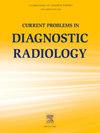Instagram reels versus image posts in radiology education
IF 1.5
Q3 RADIOLOGY, NUCLEAR MEDICINE & MEDICAL IMAGING
引用次数: 0
Abstract
Objective
In January 2016, we created an Instagram page for radiology education. Numerous publications in different fields have reported that Instagram “reels,” introduced in 2020 as a short-form video feature, are more popular than image posts. These findings and our familiarity with Instagram prompted us to analyze our own data to better understand how image posts compared with reels when used in the context of radiology education.
Materials and methods
For each post category, metric values were extracted from the Instagram platform and analyzed as continuous variables, reported as medians with interquartile ranges (IQR). Metrics were compared between image categories using the Kruskal–Wallis test, with resulting p-values adjusted for multiple comparisons using the Bonferroni correction. Corrected p-values of less than 0.05 were considered statistically significant.
Results
We included 128 images and 96 reels in the analysis. Images generally reached a larger audience, with a median of 18,745 [IQR: 13,478–27,243] impressions vs. 11,972 [IQR: 9,310.0–13,844.5] for reels (p < 0.01). Images also tended to be shared more frequently (median 19 vs. 20, p < 0.01), liked more often (median 480 vs. 296, p < 0.01), and saved more by users (median 138 vs. 84, p < 0.01) than reels, respectively. Both images and reels received a similar number of comments, with a median of 3 comments for both (p > 0.99). We also explored the performance differences of image post subcategories. Within images, our “You Make the Call!” (YMTC) questions (n = 23) displayed higher performance metrics across the board than the three other types of image posts combined (n = 105). When compared, the median number of impressions for YMTC images was 36,735 [IQR: 31,343–40,742] vs. 15,992 [IQR:12,774–21,873] for other types of images (p < 0.01). YMTC images were shared more often (median 25 vs. 17, p < 0.01), received more likes (median 809 vs. 445, p < 0.01) and saves (median 206 vs. 119, p < 0.01) than non-YMTC images, respectively. User engagement showed slightly different trends with YMTC reels being the most liked, while quiz reels receiving the most comments and talking clips being the most saved.
Conclusion
Our findings on the use of Instagram in radiology education suggest that static images perform much better than reels. Consequently, we recommend to radiology educators seeking to establish an Instagram presence that using static image posts is an appropriate approach for reaching a radiology audience, particularly with image posts that engage an audience with participatory opportunities such as answering quiz-like questions aimed at making a diagnosis.
Instagram 卷轴与放射学教育中的图片帖子。
目标:2016 年 1 月,我们创建了放射学教育 Instagram 页面。不同领域的许多出版物都报道说,Instagram 在 2020 年推出的短视频功能 "reels "比图片帖子更受欢迎。这些发现以及我们对 Instagram 的熟悉促使我们对自己的数据进行分析,以便更好地了解在放射学教育背景下,图片帖子与短片的对比情况:我们从 Instagram 平台提取了每个帖子类别的指标值,并将其作为连续变量进行分析,以中位数和四分位数间距 (IQR) 的形式进行报告。使用 Kruskal-Wallis 检验对不同图片类别的指标进行比较,并使用 Bonferroni 校正对得出的 p 值进行多重比较调整。校正后的 p 值小于 0.05 即为具有统计学意义:我们分析了 128 幅图像和 96 个卷轴。图片的受众普遍较多,中位数为 18,745 [IQR:13,478-27,243],而卷轴的中位数为 11,972 [IQR:9,310.0-13,844.5](P < 0.01)。图片的分享频率(中位数 19 vs. 20,p < 0.01)、被喜欢的频率(中位数 480 vs. 296,p < 0.01)和被保存的频率(中位数 138 vs. 84,p < 0.01)也分别高于短片。图片和卷轴收到的评论数量相似,中位数均为 3 条(p > 0.99)。我们还探讨了图片帖子子类别的表现差异。在图片中,我们的 "你说了算!"(YMTC) 问题(n = 23)的性能指标全面高于其他三类图片帖子的总和(n = 105)。相比之下,YMTC 图片的印象数中位数为 36,735 [IQR:31,343-40,742],而其他类型图片的印象数中位数为 15,992 [IQR:12,774-21,873](P < 0.01)。与非 YMTC 图片相比,YMTC 图片的分享频率更高(中位数为 25 vs. 17,p < 0.01),获得的点赞数(中位数为 809 vs. 445,p < 0.01)和保存数(中位数为 206 vs. 119,p < 0.01)也更多。用户参与呈现出略微不同的趋势,YMTC 卷轴最受喜欢,而问答卷轴收到的评论最多,谈话剪辑被保存的最多:我们关于在放射学教育中使用 Instagram 的研究结果表明,静态图片的表现要比视频短片好得多。因此,我们建议寻求在 Instagram 上建立影响力的放射学教育工作者,使用静态图片帖子是接触放射学受众的合适方法,尤其是那些让受众有参与机会的图片帖子,如回答旨在做出诊断的类似问答的问题。
本文章由计算机程序翻译,如有差异,请以英文原文为准。
求助全文
约1分钟内获得全文
求助全文
来源期刊

Current Problems in Diagnostic Radiology
RADIOLOGY, NUCLEAR MEDICINE & MEDICAL IMAGING-
CiteScore
3.00
自引率
0.00%
发文量
113
审稿时长
46 days
期刊介绍:
Current Problems in Diagnostic Radiology covers important and controversial topics in radiology. Each issue presents important viewpoints from leading radiologists. High-quality reproductions of radiographs, CT scans, MR images, and sonograms clearly depict what is being described in each article. Also included are valuable updates relevant to other areas of practice, such as medical-legal issues or archiving systems. With new multi-topic format and image-intensive style, Current Problems in Diagnostic Radiology offers an outstanding, time-saving investigation into current topics most relevant to radiologists.
 求助内容:
求助内容: 应助结果提醒方式:
应助结果提醒方式:


